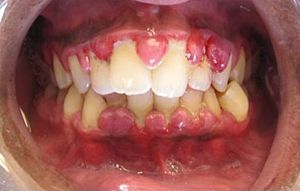Periodontal pathology
| Periodontal pathology | |
|---|---|
 |
|
| Gingival enlargement can be a feature in some periodontal diseases. | |
| Classification and external resources | |
| Specialty | Periodontology |
Periodontal pathology, also termed gum diseases or periodontal diseases, are diseases involving the periodontium (the tooth supporting structures, i.e. the gums). The periodontium is composed of alveolar bone, periodontal ligament, cementum and gingiva.
An internationally agreed classification formulated at the World Workshop in Clinical Periodontics in 1989 divided periodontal diseases into 5 groups: adult periodontitis, early-onset periodontitis, periodontitis associated with systemic disease, necrotizing ulcerative peirodontitis and refactory periodontitis.
In 1993 at the 1st European Workshop in Periodontology the earlier classification was simplified and the categories periodontitis associated with systemic disease and refractory periodontitis were dropped. Both of these classification systems were widely used in clinical and research settings. However, they failed to address a gingival disease component, had overlapping categories with unclear classification criteria and over focussed on age of onset and rate of disease progression.
Consequently, a new classification was developed at the International Workshop for a Classification of Periodontal Diseases and Conditions in 1999. This covered in much more detail the full range of periodontal diseases. "Adult periodontitis" was reclassified "chronic periodontitis" and "early-onset periodontitis" to "aggressive periodontitis". The 1999 classification represents the most recent system which was internationally accepted by experts in the field. This article follows the 1999 classification, although the ICD-10 (10th revision of the International Statistical Classification of Diseases and Related Health Problems) differs significantly.
Generally all gingival diseases share common features such as signs and symptoms being restricted to gingiva, clinically detectable inflammation, and the potential for the gum tissues to return to a state of health once the cause is removed, without irreversible loss of attachment of the teeth.
Gingivitis associated with dental plaque only
Gingival diseases modified by systemic factors
Gingival diseases modified by medications
Gingival diseases modified by malnutrition
Dental plaque is a microbial biofilm which forms on teeth. This biofilm may calcify and harden, termed calculus (tartar). Plaque tends to build up around the gingival margin (the gumline) and in gingival crevices or periodontal pocket (below the gumline). The release of waste products from the bacteria living in the biofilm causes an inflammatory response in the gums which become red and swollen, bleeding easily when disturbed. This is termed plaque-induced gingivitis and represents the most common form of gingival disease. This inflammatory response in the host can be strongly influenced by many factors such as hormonal fluctuations, drugs, systemic diseases, and malnutrition; which may allow further subdivision of plaque-induced gingivitis (see table).
...
Wikipedia
